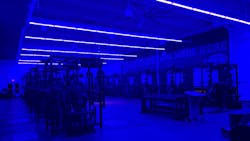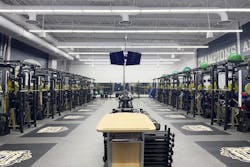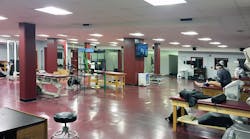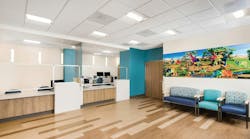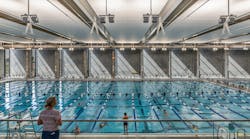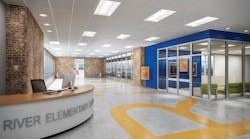For children and adolescents, moderate-to-vigorous physical activity and exercise are associated with a decrease in depression and improvements in self-esteem, concentration, and sleep. Fortunately, many school gyms and weight rooms have reopened or are reopening, but the COVID-19 pandemic continues to underscore the importance of cleaning protocols. With recent developments in germicidal LED technology, some school districts have integrated lighting in their cleaning protocols and installed products that effectively kill SARS CoV-2, influenza A, Staphylococcus aureus, and a list of pathogens that affect health and wellness.
According to the National Federation of State High School Associations’ and the Sports Medicine Advisory Committee’s “Guidance for opening up high school athletics and activities,” decreasing potential exposure to respiratory droplets is critical to preventing the spread of COVID-19. It recommends “adequate cleaning schedules should be created and implemented for all athletic facilities to mitigate any communicable diseases; and prior to an individual or groups of individuals entering a facility, hard surfaces within that facility should be wiped down and sanitized (chairs, furniture in meeting rooms, locker rooms, weight room equipment, bathrooms, athletic training room tables, etc.).”
Visible light disinfection technology in action
In 2019, voters in Chelsea, Mich., approved an $81 million school bond issue, paving the way for several projects, including a new auxiliary gymnasium to relieve an overcrowded facility at the high school. The school district planned to improve its weight training offerings for students and expand access for middle-school athletes and the community. The new facility would include two basketball practice courts, a competition court, and a 6,500-square-foot weight room.
Engineer Rich Coburn, a project manager at Strategic Energy Solutions, in Berkley, Mich., along with project architect Kingscott, in Kalamazoo, Mich., knew the weight room would be a popular destination and prioritized occupant health and safety in its design. Exercise facilities are considered high risk for transmission because of their enclosed environment, shared equipment, and close contact between users and staff. “There are always concerns about germs and bacteria when you create spaces such as weight rooms,” Coburn says. “When this project came up, it seemed like the perfect space to utilize 405-nanometer lighting technology.”
Using a combination of 405-nanometer indigo and white LEDs, Coburn specified Kenall Manufacturing’s Millenium Stretch luminaires, which use Kenall’s dual-mode Indigo-Clean technology to emit narrow spectrum light that kills viruses and bacteria while providing ambient illumination for the space. (Disclosure: The author is chief scientist and head of clinical affairs for Indigo-Clean at Kenall Manufacturing.) The luminaires use this wavelength, which falls into the visible light spectrum, to continuously kill harmful viruses and bacteria in the air and on surfaces. When the space is occupied, the luminaires operate in white disinfection mode. When the facility is closed, the fixtures switch to indigo light to provide a higher level of disinfection.
Standard room occupancy sensors control the operating mode, and the electrical inputs are identical to a typical LED luminaire. The continuous whole-room disinfection technology kills many harmful pathogens, including SARS-CoV-2, influenza A, and methicillin-resistant Staphylococcus aureus (MRSA).
Throughout the night, the luminaires disinfect the equipment with a deep cleaning. Because the technology maintains the reduced viral and bacterial levels between regular cleanings, the maintenance team can focus on other tasks.
Coburn worked with the lighting manufacturer to calculate the appropriate dose of 405-nanometer light for each room. They considered common illuminance levels for general lighting applications, the fixture design, and previous clinical studies conducted in occupied rooms with 405-nanometer fixtures. These studies demonstrated the validity of this methodology, while also incorporating the normal use of the room into the performance criteria.
User reaction and assessment
The fixtures also provide toolless access for ease of relamping and maintenance, which are important issues for Mills and his team. “Since these fixtures also use LED technology, they have a longer lifetime then older lighting technology, which will reduce maintenance costs,” Mills says.
The reaction to the disinfecting luminaires has been positive. “I’ve worked in many school districts over the past 12 years, but this is the first time I’ve encountered these lights,” says Ron Mills, the school district’s director of operations. “They’re a welcomed addition for disinfecting and cleaning, and I hope we can add them to other rooms throughout the district’s schools.”
In fact, as part of an upcoming lighting upgrade project this summer, the school will be installing the technology in two wrestling rooms, where staph such as MRSA can linger in the mats. The district is also considering an installation at its middle school weight room.
To date, testing has not been conducted to confirm the luminaires’ effectiveness. Since the weight room was newly constructed, baseline data was not collected to determine if the germicidal lighting has been effective. However, now that the luminaires have been in use for a year, the school district is considering measuring this.
